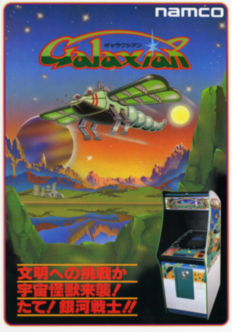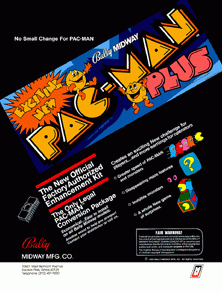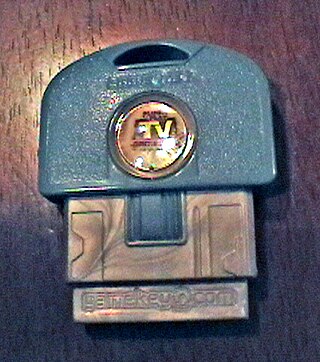
Pac-Man, originally called Puck Man in Japan, is a 1980 maze video game developed and released by Namco for arcades. In North America, the game was released by Midway Manufacturing as part of its licensing agreement with Namco America. The player controls Pac-Man, who must eat all the dots inside an enclosed maze while avoiding four colored ghosts. Eating large flashing dots called "Power Pellets" causes the ghosts to temporarily turn blue, allowing Pac-Man to eat them for bonus points.

Ms. Pac-Man is a 1982 maze arcade video game developed by General Computer Corporation and published by Midway. It is a spin-off sequel to Pac-Man (1980) and the first entry in the series to not be made by Namco. Controlling the title character, Pac-Man's wife, the player is tasked with eating all of the pellets in an enclosed maze while avoiding four colored ghosts. Eating the larger "power pellets" lets the player eat the ghosts, who turn blue and flee.

A handheld TV game or plug and play game is an integrated home video game console and game controller, usually battery powered, which connects directly to a television. The game software is built directly into the unit, which is typically designed to look like a toy or classic game console controller with the addition of a composite video cable to connect the unit. These systems usually contain either a collection of classic games or original games based on licensed properties. Because the game software is integrated into the game unit and almost never designed to be changed by the user, these game systems are typically marketed as electronic toys or collectibles rather than game consoles.

Galaxian is a 1979 fixed shooter arcade video game developed and published by Namco. The player assumes control of the Galaxip starfighter in its mission to protect Earth from waves of aliens. Gameplay involves destroying each formation of aliens, who dive down towards the player in an attempt to hit them.

Dig Dug is a maze arcade video game released by Namco in 1982. It was distributed in North America by Atari, Inc. The player digs underground tunnels to attack enemies in each level, by either inflating them to bursting or crushing them underneath rocks.

Pac-Man Plus is an arcade game that was developed by Namco and released by Bally Midway in 1982. It is part of the Pac-Man series of games.

Pac-Land is a 1984 side-scrolling arcade platform game developed and released by Namco. It was distributed in North America by Bally Midway, and in Europe by Atari Games. Controlling Pac-Man, the player must make it to the end of each stage to return a lost fairy back to its home in Fairyland. Pac-Man will need to avoid obstacles, such as falling logs and water-spewing fire hydrants, alongside his enemies, the Ghost Gang. Eating large flashing Power Pellets will cause the ghosts to turn blue, allowing Pac-Man to eat them for points.

Super Pac-Man is a 1982 maze chase arcade game developed and published by Namco. It was distributed in North America by Midway, and is Namco's take on a sequel to the original Pac-Man; Midway had previously released Ms. Pac-Man, which Namco had little involvement with. Toru Iwatani returns as designer.

Jakks Pacific, Inc. is an American toy manufacturer founded in January 1996. The company is best known for producing licensed action figures, playsets, dolls, plush toys and dress-up sets.
A dedicated console is a video game console that is limited to one or more built-in video game or games, and is not equipped for additional games that are distributed via ROM cartridges, discs, downloads or other digital media. Dedicated consoles were popular in the first generation of video game consoles until they were gradually replaced by second-generation video game consoles that use ROM cartridges.
Namco Museum is a series of video game compilations developed and published by Bandai Namco Entertainment for home video game consoles. The first title in the series, Namco Museum Vol. 1, was released for the PlayStation in 1995. Entries in the series have been released for multiple platforms, including the Game Boy Advance, PlayStation 2, PlayStation Portable, Nintendo DS and Xbox 360. the latest being Namco Museum Archives Vol. 2, released in 2020.

The Atari Flashback series is a line of dedicated video game consoles designed, produced, published and marketed by AtGames under license from Atari SA. The Flashback consoles are "plug-and-play" versions of the Atari 2600 console. They contain built-in games rather than using the ROM cartridges utilized by the 2600. Most of the games are classics that were previously released for the 2600, although some Flashback consoles include previously unreleased prototype games as well.

Pac & Pal is a 1983 maze chase arcade game developed and published by Namco. It is part of the company's Pac-Man series and the third to have been produced in-house. Players control Pac-Man as he must eat the items in an enclosed maze while avoiding four colored ghosts that pursue him. Pac-Man is assisted by a green-colored creature named Miru, the titular "Pal", who brings the items back to the center box. Pac-Man can also collect power-ups that allow him to briefly stun the ghosts.

GameKeys are expansion modules made by Jakks Pacific for the purpose of adding games to GameKey-ready entries in their Plug It In & Play TV Games product line.

The Atari Joystick Controller TV Video Game System was made in 2003 in Jakks Pacific's Plug It In & Play TV Games plug-n-play game system lineup. The device itself is designed to look like the joystick used on the Atari 2600 and has an Atari licence. It's made in China. It was sold in Europe by Revell GmbH.
AtGames Cloud Holdings Inc. is an American video game and console manufacturer, known for their Legends Ultimate Arcade and the creator of the connected arcade. Since 2011, they have produced and marketed the Atari-licensed dedicated home video game console series Atari Flashback under license from Atari. Additionally, AtGames has produced ColecoVision and Intellivision Flashback consoles, and has worked with Sega on multiple different handhelds and retro consoles.













